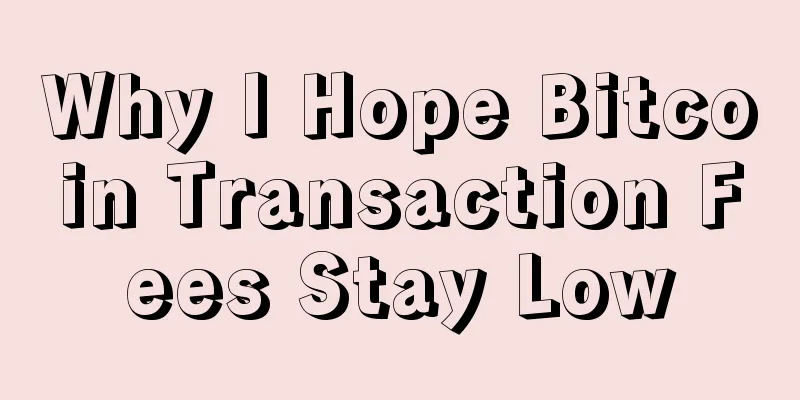Why I Hope Bitcoin Transaction Fees Stay Low

Chapter 0 IntroductionIn the recent expansion controversy, many people believe that if the block size does not increase, the mining fee can be increased to adjust the Bitcoin transaction congestion. Anyone who wants to use Bitcoin will have to pay more fees. Through the paid bidding mechanism, their transactions are guaranteed to be confirmed by miners. This seems to be in the interests of miners, which is conducive to the stability and growth of the computing power of the entire network, thus ensuring network security. But I think this is not feasible. Increasing mining fees can indeed reduce network congestion because it will greatly reduce the number of transactions, but miners cannot get more benefits. It is difficult for the Bitcoin network economy to transition from block rewards to mining fee rewards. The final outcome is likely to be a decrease in computing power, the network becoming unsafe, and POW failure. This article attempts to express the logic of my reasoning. Chapter 1 Who is more scarce in the Bitcoin economic system: users or miners?On the topic of how much mining fees to charge, we all think that this is an economic issue. Users pay more mining fees in order to compete for transactions to be confirmed as soon as possible. This is equivalent to treating computing power as a scarce resource and letting users compete. If the mining fees are maintained low, it is equivalent to treating users as scarce resources and using low fees to attract users. Similar business operations are too common. For example, in the competition between Alipay and UnionPay, Alipay faces the problem that the number of users is scarce. Therefore, Alipay uses free transfers to attract users, while UnionPay is not worried about the number of users because it monopolizes the underlying settlement of the entire RMB. The recent incident of a Northeastern girl complaining about scalpers raising registration fees on Weibo shows another situation, that is, famous doctors are scarce, and patients must pay fees to compete with other patients in order to get treatment from famous doctors. The development process of the entire Internet product has a very obvious pattern, which is from the earliest paid use, to free use, to the current subsidized user use. Why is this so? One of the reasons is that the marginal cost of Internet products is close to zero, that is, the additional operating cost of serving one more user is almost zero. The second reason is that Internet products often have network effect value, that is, the more users there are, the higher the value of the product. The third reason is that now is an era of extreme material abundance, and the essence of competition between products is to compete for user time. Just like we can use Alipay to pay, we can also use WeChat Pay, and the user experience of the two is not much different. The product that users use more time will win in the competition. It can be said that as long as the marginal cost of a product with network effects is close to zero, the product competition among companies will develop in the direction of competing for the number of users, and they will use free or even subsidized methods to attract users. Now back to mining and the number of user transactions, is computing power more scarce or the number of Bitcoin users more scarce? At this stage, I think the number of users is more scarce. We all agree that one of the sources of Bitcoin's value is the network effect. The more users there are, the higher its value. This is just like a fax machine. If there is only one fax machine in the world, then this fax machine is useless. The more fax machines there are, the more value each fax machine can bring out. Because we need more and more users to make the value of Bitcoin emerge. On the other hand, the current value of Bitcoin is not high enough because users are too scarce. Are miners scarce? For Bitcoin, computing power guarantees security, which is one of the cornerstones of Bitcoin. The higher the computing power, the more secure the network is. From this perspective, computing power is also scarce. Since we need to increase the number of users and improve computing power at the same time, can we use the mining fee as a lever to make adjustments? We must admit that if we open our eyes to human nature, we will know that if the mining fee is increased, it will not be conducive to attracting new users, thereby hindering the expansion of Bitcoin's value. Another fact we must admit is that the growth of computing power does not directly increase the value of Bitcoin. For example, the current 1000P will not make the value of Bitcoin higher than when it was 100P. There is no direct relationship (of course there is an indirect relationship). But the value of Bitcoin is directly related to the number of users, which is the network effect. Then my question becomes, can we increase computing power by hindering the expansion of Bitcoin’s value? The answer is obviously no! Because the biggest motivation for mining is still the rise in Bitcoin prices. Chapter 2 The most important driving force behind the increase in computing power is the increase in Bitcoin pricesMining is one of the biggest applications of Bitcoin. People who invest in mining are essentially investing in Bitcoin. Most miners should calculate their mining income by the amount of money converted into legal currency, rather than directly calculating the number of Bitcoins obtained. Of course, there are still a few idealists who will oppose this, but this does not harm the mainstream driving force for the expansion of Bitcoin computing power - the rise in Bitcoin prices. As long as the price goes up, more and more people will mine, and the computing power will increase, until the profits from mining are evenly distributed and are not enough to support the mining costs. The rise in Bitcoin prices can be explained by the iron law of economics, that is, the relationship between supply and demand. The supply of Bitcoin is fixed, which is written in mathematical laws, 3,600 BTC a day. But the demand is expanded according to the growth of the number of users. In other words, the continuous growth of the number of Bitcoin users can continue to drive the rise in Bitcoin prices. If you agree with this, then the development of Bitcoin should not consider adopting a method that harms the increase of users. In the final analysis, mining is the process of using energy to transfer into Bitcoin. The main costs come from manufacturing mining machines, building mining farms and energy costs. These costs are all denominated in legal currency. The income from mining is divided into two parts: one is the block reward, and the other is the miner's fee. These incomes are directly denominated in Bitcoin, and then can be converted into legal currency by multiplying the currency price. If we consider the long term, after the block reward has been halved several times, if the mining fee multiplied by the coin price is not enough to cover the miner's cost and support the miner's income? What should we do? Based on this, some people think that we should start to consider increasing the mining fee now to cultivate users' habit of paying more to meet the computing power income demand at that time. We must admit that this situation is very likely to happen, and it may even cause a decrease in computing power, resulting in insufficient guarantee of Bitcoin security. If this happens, is it necessary to increase the mining fee? I will first answer why not, and then answer whether there are other ways. Chapter 3: Even if the block reward cannot cover the computing power cost, the mining fee should not be increased significantlyBased on a certain computing power, there are two ways to increase miners' income. One is to increase the mining fee; the other is to increase the number of transactions. Obviously, increasing the mining fee will reduce the number of transactions. However, increasing the number of transactions will not seriously affect the miners' costs. This is the marginal cost close to zero. For miners with computing power, when calculating a block, the cost of packaging one transaction and packaging 10,000 transactions is almost the same. In products with marginal costs close to zero, low handling fees will be evolved to promote the increase in the number of transactions and obtain more mining fee income. The cost of mining is easy to estimate. The data on Bitcoin can be easily queried. In this case, users will reverse the mining cost and estimate the handling fee they should pay. If miners charge more handling fees, or promote the increase of handling fees by limiting the block size, it will cause confrontation between users and miners. This will cause users to flee. Including migrating transactions to offchain and lightning networks, or even leaving Bitcoin. Miners' income will decrease instead of increase. In other words, miners cannot obtain information price difference. Finally, Bitcoin miners have many competitors, and the technical barriers to entry into Bitcoin payment and settlement are very high, and it does not require too many resources to operate. It is not difficult to make an offchain wallet. It is unlikely that miners can increase mining fees while retaining a sufficient number of transactions. This is why I believe that as long as the transaction fees are increased, transactions will inevitably leave Bitcoin mining in large numbers, causing miners' income to further decline and computing power to be no longer guaranteed. So if miners cannot significantly increase mining fees and there are no block rewards to guarantee miners' profits, does the Bitcoin economy have other profit models to maintain computing power? Chapter 4 Other Profit Models of MiningWe can get some inspiration from the business model of free products on the Internet. Internet products that are free or even subsidized to users can be summarized into three profit models. One is that basic services are free, but value-added services are charged. For example, many QQ accounts can be used for free, but QQ membership privileges can be sold. The second is a three-party market, where one type of customer subsidizes another type of customer. For example, Google's keyword advertising model. Using search is free, using Google's products is free, and it earns huge revenue from advertising. Another type is direct cross-subsidy, for example, Apple software is almost free and can be upgraded unlimitedly, but hardware is charged. In addition to block rewards and mining fees, is it possible to generate other profits from Bitcoin mining? Many mining pools now provide engraving services, which is a value-added service. BTCC and AntPool both provide such services of leaving messages on the blockchain for a certain fee. This is an innovation. Although it is just a drizzle at present, as long as a seed is planted, there is hope that it will grow into a big tree. This at least shows that mining can still bring other benefits. If we consider the miners’ packaging of transaction records as a basic service, we can charge a relatively low service fee to ensure user traffic. Are there additional value-added services for innovation? I haven’t thought of it yet. If I could think of it, I could start a company. But it must be there. The only blockchain in the world, with such good soil, will surely grow a lot of fruits. What I meant by writing this is that miners don’t have to focus entirely on how to extract transaction fees from users. As long as they can cultivate a large number of users, there will be plenty of opportunities to make money. Chapter 5: Competition between Miners and UsersLet's talk about Bitcoin's mining fees and miners. What we must confirm is that users paying mining fees is essentially a competition between users for the right to use computing power. There is no competitive relationship between miners and users, they are in a mutually beneficial relationship. Miners can only compete with other miners. Just like the recent registration fee girl incident, the girl thought that there was a competition between the scalpers and her, and that the scalpers bought the tickets and then sold them at a high price. In fact, it was not like that. It was because there were too many patients who wanted to see this expert, and these patients competed with the girl for registration. It was other patients who made it difficult for the girl to register. If there were not so many patients, the scalpers would not have the opportunity to sell at such a high price. Back to the mining fee, how much the user should pay for the mining fee should be the result of competition between users. If a user wants to get faster packaging confirmation, he will pay more for the mining fee. But who are miners competing with? If we open our eyes, we will see that the competition is between miners. If you collect the mining fee, I will have nothing, so miners should take the initiative to provide better packaging services. This is obvious, so all miners are trying to increase their computing power in an effort to get more packaging opportunities. Then miners also compete with offchain wallet providers. Users of offchain wallets transfer bitcoins, which has nothing to do with miners. Bitcoin miners also compete with miners of other currencies. If users use Litecoin instead of Bitcoin, they will not be able to receive mining fees from Bitcoin miners. If you agree with my perspective, then as a miner, you must not compete with Bitcoin transfer users. The two are in a cooperative and mutually beneficial relationship. However, if miners unilaterally and unreasonably increase mining fees, or try to create a competitive relationship between users by limiting the block size, and thus make profits, they are destroying the cooperative and mutually beneficial relationship between miners and users. This is to force users out of the Bitcoin blockchain. Chapter 6: Don’t Forget the Ideals of BitcoinOne of the ideals of Bitcoin is to check the government's excessive issuance of currency. Look at the world map and see which governments issue the worst currencies. It is Africa, South America, Central Asia, and these poor countries. The people in these poor countries have been bullied by their governments. Their governments don't even need to use guns, they just print some money and rob the people. If Bitcoin wants to provide monetary services to these poor people, they cannot afford the high transfer fees. Chapter 7: High mining fees may harm the authenticity of blockchains such as BitcoinI have discussed this point in my previous article "If you want to settle a network, why not use POS?", so I will not repeat it in detail here. Interested readers can click on the link and read Chapter 6 of the article. I will just briefly talk about it here. As the transaction fees of the main chain increase, users will be forced to go to offchain, sidechain, lightning network, etc., and there is no POW on the non-main chain to ensure the authenticity of Bitcoin, just like the coins on the exchange may not be 100% reserved. And because the transaction fees on the main chain are high, if you want to use the main chain to verify the authenticity of Bitcoin on these side chains, the cost is high, and ordinary users cannot afford it. This will result in low cost for counterfeiting coins on the side chains, and finally people will doubt the authenticity of the entire ecosystem. This is the same reason why we are now beginning to doubt whether the coins on exchanges are real. Chapter 8 ConclusionHere are the reasons why I think Bitcoin mining fees need to remain low: The first is that the price value of Bitcoin comes from the network effect, which determines that users are more scarce than computing power. It is necessary to encourage new users to join through low transaction fees. The second is that the most favorable guarantee of computing power comes from the rise in Bitcoin prices, and the solid foundation for driving the price of the currency is the number of users. Third, the business model of mining to obtain mining fees is similar to marginal cost close to zero, which is conducive to low mining fee operations. Fourth, mining can develop other income besides mining fees and block rewards. Fifth, miners’ competitors are offchain and other currencies, not users. Sixth, Bitcoin should provide services to the poor. Seventh, high mining fees will increase the difficulty of verifying the authenticity of the Bitcoin ecosystem. So I think it is necessary to keep Bitcoin transfer fees at a low level in the long term. Thanks for reading. If you find the article useful, please give me some Bitcoin to encourage me to continue writing. Author: tan90d (Weibo @LightningHSL WeChat tan90d) |
<<: How can blockchain enter the mainstream? 5 strategies analyzed
>>: Bitcoin is one step away from its next crash
Recommend
How will the fortune be for people born in the Year of the Ox with a mole of misery in 2019?
Moles are common to many people, because everyone...
Is it bad to smile with your mouth tilted to the left?
When talking about outstanding facial features, p...
Are girls with small ears particularly stingy?
Are girls with very small ears particularly sting...
Which women are born blessed according to palmistry
1. Soft as jade It is soft as if without bones, w...
Vitalik: Ethereum 3.0 will achieve "infinite" scalability in 2018
Vitalik Buterin has set Ethereum’s development mi...
Which men look kind but are cruel and violent?
What women hope for is to find a good husband and...
Palm lines diagram How to see the fortune of this life from the palm star hill Palm star lines see the fortune of this life
How does the star hill on the palm predict your f...
Jin Zizai's fortune-telling: What kind of woman is suitable for early marriage?
When it comes to early marriage, we must understa...
Litecoin Segregated Witness Blocked, Founder Considers User-Activated Soft Fork
In the world of cryptocurrency, it’s only a matte...
What does the mole on a man's wife mean?
The position of moles is closely related to a per...
How to judge a person's character from the mahjong table
As the saying goes: The hemp field is like a batt...
Five types of women's faces that will bring bad luck to their husbands
Five types of women's faces that will bring b...
Women with straight noses not only have good fortune but also bring luck to their husbands, right?
For some people, they do consider how their facia...
What does a mole on the side of the nose mean and how does it affect your destiny?
Many people have moles on their faces, and differ...
Live Preview | BTC halving night, come and witness history together!
The cryptocurrency industry is about to usher in ...









